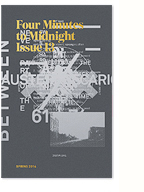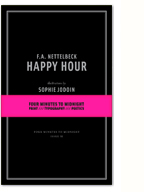Filed under: reading and writing
The following is an observational “essay” featured in Issue 7 of four minutes to midnight:
SIMON DAVIES
During the orientation session at Post St. Joost in Breda, the Netherlands, my soon to be professor, Simon Davies mentioned to me in passing;
I think the antiquated notion of (graphic) design as problem solving should be buried and replaced with an understanding of design as a process of problem revealing.
I identified strongly with Simon’s words as I’ve never really thought of myself as a very good problem solver, but would still like to consider myself a competent designer. No doubt graphic design does solve some problems. But in the grand scheme of problems, differentiating products in the market and making a text more legible seem pretty trivial, and certainly not important enough to be the basis of a profession. This shouldn’t be seen to discount the important place of good (moral?) craft work within society, but the extension of the designer’s role as official “problem-solver” is based in an ideal of modernism, with design acting in the service of (the captains of) industry. Whose problems have we really been solving all these years?
As a socially engaged designer, a constant rebuttal to my idealism is that graphic design can do nothing to solve the problems of poverty, hunger, environmental destruction or war. The argument continues, who are we to pretend we know the solution to these problems? We’re artists, not (political) scientists. Therefore, we should stick to what we know, get on with doing good work, and solve the problems we’ve been trained to solve (justified or ranged-left? definitely ranged-left…).
Yet the second half of Simon’s statement offers an alternative to this simplistic argument. Without getting into the “designer as author” debate, the common understanding of graphic design is one where the designer works with predetermined content. The very same processes of organisation, clarification and differentiation that have been linked with solving, can more naturally be seen as revealing that which already exists within the content. Identifying what to reveal and how to reveal it (and whom to reveal it to), is the starting point for design as a rhetorical practice, from which an argument can be formed (argument as solution? believe me because I’m good..) or from which questions can be asked (do you believe me because I’m pretty?).
Seen in this light, the question of whom we are serving becomes all the more pertinent.The line between solving and revealing is blurry, yet a reversal of perspective could open up real spaces for question-ing and dialogue. When asked what I know about solving the problems of global warming, I ask what do I really know about the effects of selling ??????? (insert product here). But this isn’t simply the issue of selling versus telling, it is a basic questioning of our acceptance of our role/ability to tell. Maybe we should focus on our ability to show…
HUGUES BOEKRAAD
Three months later, I had made the decision to leave the Netherlands, broken-hearted and broken-spirited. On a misty December evening, Hugues, my theory professor, asked me why I was leaving. In a moment of clarity, I responded that I was leaving because I recognised my own weakness. He nodded and replied that it was good that I could recognise this:
I’ve never had to deal with that, I’m strong of body, strong of mind, I’m smarter than most people I know. Yet, I’ve had friends who were far weaker, far stupider than me, who managed to achieve more because they accepted their own weakness. Remember Kevin, in your struggle against capitalism, if you can recognise how truly weak you are, how small you are, how impotent you are, then you’ll be able to do great things.
Beyond the surrealism of that moment, with Hugues relating my struggle to capitalism (while I was pining over lost love), the idea of recognising my own weakness has stayed with me ever since. I’ve asked myself what he meant with this contradictory statement, and in different instances come up with different answers.
At first, it meant learning patience, learning how to delay dreams and temper ambitions. To accept pain and let wounds heal.
Another obvious and practical answer (which I therefore doubt is what he meant), is to not be afraid to ask for help, constantly. To know how to swallow your pride and be genuinely open to support and collaboration. Together we stand…
Less optimistically, I’ve also learned how recognising weakness means making very real compromises with reality. That in order to stay alive, you have to sell some things, and you better sell it well, and sell it cheap. The machinery of capitalism is vast, and I am small.These reflections might seem like tired platitudes, but sometimes it takes a big man telling you just how small you are in order to face up to them.
GRAHAM WOOD
I wrote Graham asking for help. I’ve always admired his design/art/writing practice, both as part of Tomato and individually. I’d never met him before, yet in asking for help, I was unusually frank, explaining in great personal detail why I needed it. He replied:
i don’t know what the (or at least my own) drive to transform? or hope? or actually communicate really comes from—i don’t think i’ll ever really know and i know i don’t want to know anymore because it gets more and more irrelevant as time passes. i know what you mean about crying to bon jovi—so called ‘crap’ hollywood movies get me that way very very often… the most recent was the ‘last samurai’ but you know what they say about cliches and truth… i think i’m always starting again—not in a ‘you’re only as good as your last work’ way, but because you just never know—what something will be, where it will lead… whether it will be worth it… i think i lost my ability to expect anything (well, miracles and disasters at least) a long long time ago and because of that i’ve found life to be… life. we can’t all be saints but you can hold a door open every so often—just realising that we’re on a planet along with other people can sometimes be a bit of a shock.
by the way (not advice, just an aside)—marry the next girl you want to go out with. it sorts all the shit out—for a while, if not a lifetime (if you’re… lucky)—and you can get on with the things that really matter. a quote i always think of is “i’ve seen too many men driven insane by their distractions.”
ABE BURMEISTER
I sent Abe a link to a political design project produced at Design Inquiry, On Secession and Reclamation. He was unimpressed and when I asked him why, he answered:
I know it’s well intended, but that is one of the most misguided sites I’ve seen in a while. Pushing deep division when what’s needed is working unity, and one of their main charges against Bush is that he promotes disunity! I spent the election out in Ohio working to swing things. When I came back there was a lot of talk about “they”, “them”, and the sky falling. It killed me a little, because when I left people were mainly concerned with what to do for halloween. And more to the point, if you think of people as “they and them” then you’re not going to get much popular support are you? For all the American left talks about being for the people they sure don’t talk to too many people. I didn’t meet any “theys” out in Ohio, just real people with real concerns.
Over the last few years, I’ve had quite a few brief email exchanges with Abe around issues of social change. He’s explained to me, in unambiguous terms, why he’s moved away from the concept of resistance to one of transformation and construction, “not only does resistance promote conflict, it also implies a resignation to failure.”
Though I agree with him in principle, I know I’m still very seduced by the rhetoric of resistance. And though I can understand it as rhetoric, I believe that in these times, there’s a genuine necessity for making (dissident/resistant) rhetorical arguments. I’m scared shitless of what would happen if we stopped speaking of revolution.
Yet it’s also been a long time since I’ve worked on the ground, and Abe’s words do just that, grounding me, making me realise the practicality and importance of the choices we make. Moreover, his ability to move ‘beyond’ a position of resistance empowers me to believe that my own anger can become more constructive and progressive, given a commitment of my time and will.
STUART EWEN
Three years ago I wrote a thesis on graphic design and the politics of visual culture that was largely structured around arguments made in Stuart Ewen’s book, All Consuming Images. Last month, much to my delight, I receive an email from him out of the blue:
Kevin: I just found your site. It’s needed now more than ever. Best, Stuart Ewen.
As I write this, I realise that there’s very little to say about these three little sentences. They are neither meaningful nor thought provoking to anyone but me (how did he find my website? why does he think it’s needed?). Their inclusion here is simply a projection of my bolstered ego.We all need a little encouragement sometimes…
more from GRAHAM WOOD
the problem is most likely designers themselves. too many of them, caught in a torturous circle of ego and servility they end up losing sense of what is intended (or deliberately unintended or left open) and what is forced until, bitter, lost, they retreat into conservatism, toeing the line even in the face of other valid and workable ways of being.
assumption, not thought, underlies the majority of so-called decisions they make. they wait to be given the brief and reflex drives the process until, all potential life willingly wrung and drained from a project (to ensure there is comfort, to ensure there are no surprises), something stillborn adorns the pages and screens of the world. all inspiration comes from the project on the table and the pages of design annuals. give them a pencil and a piece of paper and they won’t know what to do. to think that brian eno or stanley kubrick or the heart sutra or a stick standing next to a stone in a forest might have some relationship to the project for the client is anathema.
that there may be many ways to do what is best for the project—let alone the fact that there are many things they could be doing that has no ‘client’ but their own passion and commitment—is implausible, a fiction beyond imagination. they deny art (and therefore life) as if it were a form of fascism, and deny thought like creationists deny the evidence of the rocks.
they are complicit in a lie that has no balance and would only be balanced if they realised that in the very nature of design is the act of biting the hand that feeds you: it is this knowledge and the ability to act on it that makes powerful, living design-and it is this ability that is ultimately the downfall of the most committed designers.
No Comments so far
Leave a comment
Leave a comment














